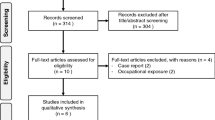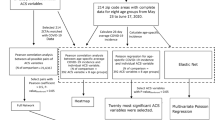Abstract
We conducted a large epidemiologic case-control study in California to examine the association between childhood cancer risk and distance from the home address at birth to the nearest high-voltage overhead transmission line as a replication of the study of Draper et al. in the United Kingdom. We present a detailed description of the study design, methods of case ascertainment, control selection, exposure assessment and data analysis plan. A total of 5788 childhood leukemia cases and 3308 childhood central nervous system cancer cases (included for comparison) and matched controls were available for analysis. Birth and diagnosis addresses of cases and birth addresses of controls were geocoded. Distance from the home to nearby overhead transmission lines was ascertained on the basis of the electric power companies’ geographic information system (GIS) databases, additional Google Earth aerial evaluation and site visits to selected residences. We evaluated distances to power lines up to 2000 m and included consideration of lower voltages (60–69 kV). Distance measures based on GIS and Google Earth evaluation showed close agreement (Pearson correlation >0.99). Our three-tiered approach to exposure assessment allowed us to achieve high specificity, which is crucial for studies of rare diseases with low exposure prevalence.
This is a preview of subscription content, access via your institution
Access options
Subscribe to this journal
Receive 6 print issues and online access
$259.00 per year
only $43.17 per issue
Buy this article
- Purchase on Springer Link
- Instant access to full article PDF
Prices may be subject to local taxes which are calculated during checkout



Similar content being viewed by others
References
Howlader N, Noone AM, Krapcho M, Neyman N, Aminou R, Altekruse SF et al SEER Cancer Statistics Review, 1975-2009 (Vintage 2009 Populations),. Bethesda, MD, USA. 2012.
Pui C-H . Childhood Leukemias. Cambridge University Press: Cambridge, UK. 2006, 960 p.
Greaves M . Childhood leukaemia. Bmj 2002; 324: 283–287.
Schuz J, Grell K, Kinsey S, Linet MS, Link MP, Mezei G et al. Extremely low-frequency magnetic fields and survival from childhood acute lymphoblastic leukemia: an international follow-up study. Blood Cancer J 2012; 2: e98.
Wertheimer N, Leeper E . Electrical wiring configurations and childhood cancer. Am J Epidemiol 1979; 109: 273–284.
Kheifets L, Shimkhada R . Childhood leukemia and EMF: review of the epidemiologic evidence. Bioelectromagnetics 2005; (Suppl 7): S51–S59.
Ahlbom A, Day N, Feychting M, Roman E, Skinner J, Dockerty J et al. A pooled analysis of magnetic fields and childhood leukaemia. Br J Cancer 2000; 83: 692–698.
Greenland S, Sheppard AR, Kaune WT, Poole C, Kelsh MA . A pooled analysis of magnetic fields, wire codes, and childhood leukemia. Childhood Leukemia-EMF Study Group. Epidemiology 2000; 11: 624–634.
Kheifets L, Ahlbom A, Crespi CM, Draper G, Hagihara J, Lowenthal RM et al. Pooled analysis of recent studies on magnetic fields and childhood leukaemia. Br J Cancer 2010; 103: 1128–1135.
Draper G, Vincent T, Kroll ME, Swanson J . Childhood cancer in relation to distance from high voltage power lines in England and Wales: a case-control study. Bmj 2005; 330: 1290.
Kroll ME, Swanson J, Vincent TJ, Draper GJ . Childhood cancer and magnetic fields from high-voltage power lines in England and Wales: a case-control study. Br J Cancer 2010; 103: 1122–1127.
Kheifets L, Feychting M, Schuz J . Childhood cancer and power lines: results depend on chosen control group. Bmj 2005; 331: 635.
The California Cancer Registry Mission Statement & Purpose Sacramento, CA [2009] Available from http://www.ccrcal.org/abouttheccr.html.
Oksuzyan S, Crespi CM, Cockburn M, Mezei G, Kheifets L . Birth weight and other perinatal characteristics and childhood leukemia in California. Cancer Epidemiol 2012; 36: e359–e365.
Oksuzyan S, Crespi CM, Cockburn M, Mezei G, Kheifets L . Birth weight and other perinatal factors and childhood CNS tumors: a case-control study in California. Cancer Epidemiol 2013; 37: 402–409.
Goldberg D, Cockburn M . Improving geocode accuracy with candidate selection criteria. Transactions in GIS 2010; 14: 149–176.
United States Census Bureau Geography: Zip Code Tabulation Areas 2012 [cited 2012 April 2] Available from http://www.census.gov/geo/reference/zctas.html.
Electric Power Research Institute Pilot Study for the Replication of the Draper Study of Leukemia, Brain Tumors, and Distance to Power Lines in California. Palo Alto, CA: EPRI 2008 Contract No.: 1014939.
O’Neill Ean editor California’s Transmission Challenges for Interconnecting Renewables 2011 Mach 29.
Bonneville Power Administration (BPA) Description of Equations and Computer Program for Predicting Audible Noise, Radio Interference, Television Interference, and Ozone from A-C Transmission Lines 1977 September Report No.: Contract No.: ERJ-77-167.
Electric Power Research Institute (EPRI) EMF Workstation 2012. 3420 Hillview Avenue, Palo Alto, CA 2012, Contract No.: 1023794.
Lange B . The management of neoplastic disorders of haematopoiesis in children with Down’s syndrome. Br J haematol 2000; 110: 512–524.
Rubin DB, Schenker N . Multiple imputation in health-care databases: an overview and some applications. Stat Med 1991; 10: 585–598.
Little R, Rubin D . Statistical Analysis with Missing Data 2nd Edition ed Wiley: New York, NY, USA. 2002.
Mezei G, Kheifets L . Selection bias and its implications for case-control studies: a case study of magnetic field exposure and childhood leukaemia. Int J Epidemiol 2006; 35: 397–406.
Greenland S, Kheifets L . Leukemia attributable to residential magnetic fields: results from analyses allowing for study biases. Risk Anal 2006; 26: 471–482.
Langholz B . Factors that explain the power line configuration wiring code-childhood leukemia association: what would they look like? Bioelectromagnetics 2001; (Suppl 5): S19–S31.
Jones TL, Shih CH, Thurston DH, Ware BJ, Cole P . Selection bias from differential residential mobility as an explanation for associations of wire codes with childhood cancer. J Clin Epidemiol 1993; 46: 545–548.
Sahl JD . Viral contacts confound studies of childhood leukemia and high-voltage transmission lines. Cancer Causes Control 1994; 5: 279–283.
Bessou J, Deschamps F, Figueroa L, Cougnaud D . Methods used to estimate residential exposure to 50 Hz magnetic fields from overhead power lines in an epidemiological study in France. J Radiol Protection 2013; 33: 349–365.
Pedersen C . Distance from residence to nearest power line and the risk of childhood leukaemia: a population-based case-control study in Denmark. Childhood Cancer 2012. Children With Cancer UK: London, UK. 2012.
Acknowledgements
This project was supported by a research contract from the Electric Power Research Institute (EPRI) to the UCLA and by the UCLA Faculty Grants Program. Crespi was also supported by National Institutes of Health grant CA16042. The study was approved by University of California, Los Angeles (UCLA) Office for the Protection of Research Subjects, University of Southern California IRB, and California Committee for the Protection of Human Subjects (CPHS). We thank Kevin Hooper for GE validation and site visit work. We are grateful to participating utilities for time and effort in providing crucial data for this study.
Author information
Authors and Affiliations
Corresponding author
Ethics declarations
Competing interests
The authors declare no conflict of interest.
Rights and permissions
About this article
Cite this article
Kheifets, L., Crespi, C., Hooper, C. et al. Epidemiologic study of residential proximity to transmission lines and childhood cancer in California: description of design, epidemiologic methods and study population. J Expo Sci Environ Epidemiol 25, 45–52 (2015). https://doi.org/10.1038/jes.2013.48
Received:
Revised:
Accepted:
Published:
Issue Date:
DOI: https://doi.org/10.1038/jes.2013.48
Keywords
This article is cited by
-
The role of dwelling type when estimating the effect of magnetic fields on childhood leukemia in the California Power Line Study (CAPS)
Cancer Causes & Control (2020)
-
The sensitivity of reported effects of EMF on childhood leukemia to uncontrolled confounding by residential mobility: a hybrid simulation study and an empirical analysis using CAPS data
Cancer Causes & Control (2019)
-
Residential magnetic fields exposure and childhood leukemia: a population-based case–control study in California
Cancer Causes & Control (2017)
-
Childhood leukaemia and distance from power lines in California: a population-based case-control study
British Journal of Cancer (2016)



